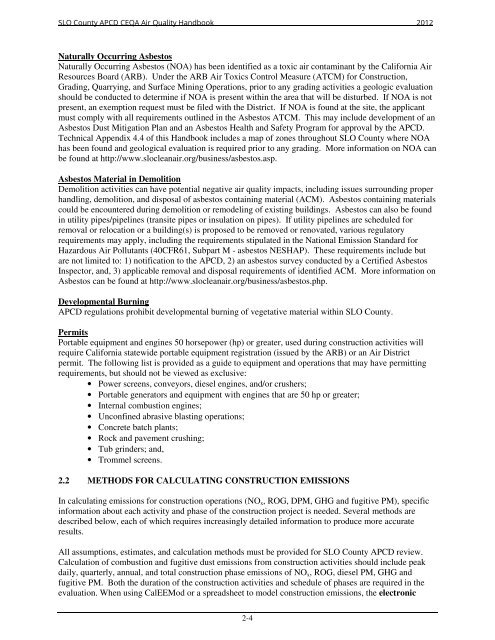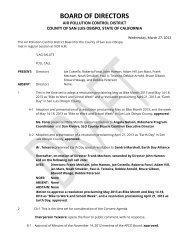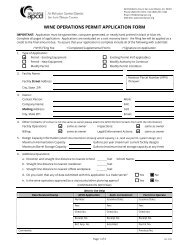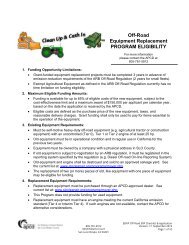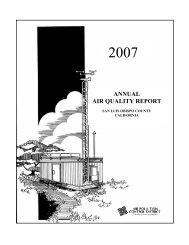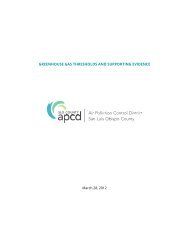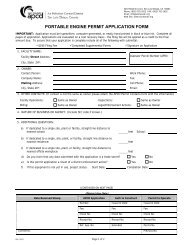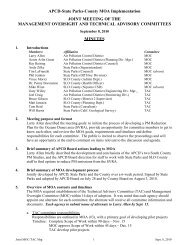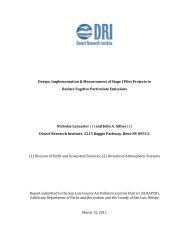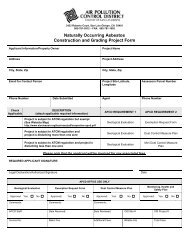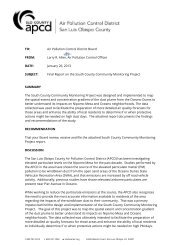CEQA Air Quality Handbook - Air Pollution Control District
CEQA Air Quality Handbook - Air Pollution Control District
CEQA Air Quality Handbook - Air Pollution Control District
You also want an ePaper? Increase the reach of your titles
YUMPU automatically turns print PDFs into web optimized ePapers that Google loves.
SLO County APCD <strong>CEQA</strong> <strong>Air</strong> <strong>Quality</strong> <strong>Handbook</strong> 2012<br />
Naturally Occurring Asbestos<br />
Naturally Occurring Asbestos (NOA) has been identified as a toxic air contaminant by the California <strong>Air</strong><br />
Resources Board (ARB). Under the ARB <strong>Air</strong> Toxics <strong>Control</strong> Measure (ATCM) for Construction,<br />
Grading, Quarrying, and Surface Mining Operations, prior to any grading activities a geologic evaluation<br />
should be conducted to determine if NOA is present within the area that will be disturbed. If NOA is not<br />
present, an exemption request must be filed with the <strong>District</strong>. If NOA is found at the site, the applicant<br />
must comply with all requirements outlined in the Asbestos ATCM. This may include development of an<br />
Asbestos Dust Mitigation Plan and an Asbestos Health and Safety Program for approval by the APCD.<br />
Technical Appendix 4.4 of this <strong>Handbook</strong> includes a map of zones throughout SLO County where NOA<br />
has been found and geological evaluation is required prior to any grading. More information on NOA can<br />
be found at http://www.slocleanair.org/business/asbestos.asp.<br />
Asbestos Material in Demolition<br />
Demolition activities can have potential negative air quality impacts, including issues surrounding proper<br />
handling, demolition, and disposal of asbestos containing material (ACM). Asbestos containing materials<br />
could be encountered during demolition or remodeling of existing buildings. Asbestos can also be found<br />
in utility pipes/pipelines (transite pipes or insulation on pipes). If utility pipelines are scheduled for<br />
removal or relocation or a building(s) is proposed to be removed or renovated, various regulatory<br />
requirements may apply, including the requirements stipulated in the National Emission Standard for<br />
Hazardous <strong>Air</strong> Pollutants (40CFR61, Subpart M - asbestos NESHAP). These requirements include but<br />
are not limited to: 1) notification to the APCD, 2) an asbestos survey conducted by a Certified Asbestos<br />
Inspector, and, 3) applicable removal and disposal requirements of identified ACM. More information on<br />
Asbestos can be found at http://www.slocleanair.org/business/asbestos.php.<br />
Developmental Burning<br />
APCD regulations prohibit developmental burning of vegetative material within SLO County.<br />
Permits<br />
Portable equipment and engines 50 horsepower (hp) or greater, used during construction activities will<br />
require California statewide portable equipment registration (issued by the ARB) or an <strong>Air</strong> <strong>District</strong><br />
permit. The following list is provided as a guide to equipment and operations that may have permitting<br />
requirements, but should not be viewed as exclusive:<br />
• Power screens, conveyors, diesel engines, and/or crushers;<br />
• Portable generators and equipment with engines that are 50 hp or greater;<br />
• Internal combustion engines;<br />
• Unconfined abrasive blasting operations;<br />
• Concrete batch plants;<br />
• Rock and pavement crushing;<br />
• Tub grinders; and,<br />
• Trommel screens.<br />
2.2 METHODS FOR CALCULATING CONSTRUCTION EMISSIONS<br />
In calculating emissions for construction operations (NO x , ROG, DPM, GHG and fugitive PM), specific<br />
information about each activity and phase of the construction project is needed. Several methods are<br />
described below, each of which requires increasingly detailed information to produce more accurate<br />
results.<br />
All assumptions, estimates, and calculation methods must be provided for SLO County APCD review.<br />
Calculation of combustion and fugitive dust emissions from construction activities should include peak<br />
daily, quarterly, annual, and total construction phase emissions of NO x , ROG, diesel PM, GHG and<br />
fugitive PM. Both the duration of the construction activities and schedule of phases are required in the<br />
evaluation. When using CalEEMod or a spreadsheet to model construction emissions, the electronic<br />
2-4


